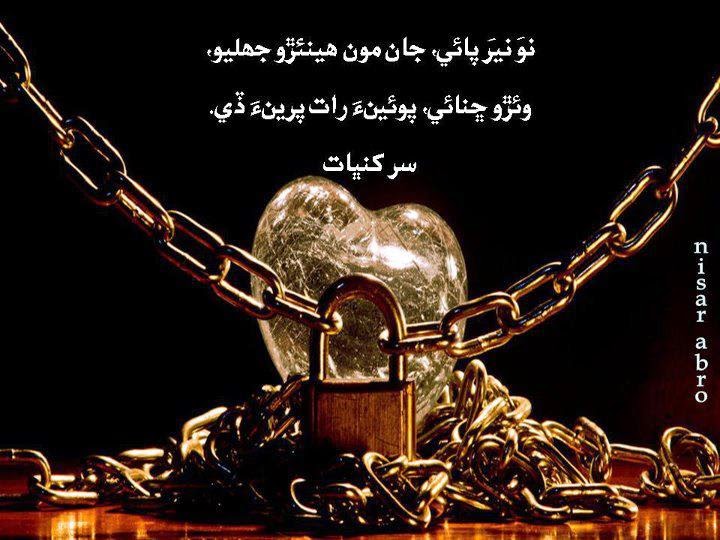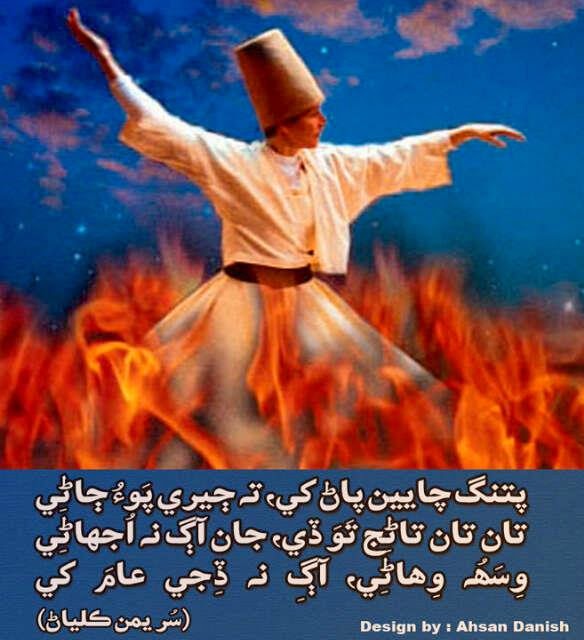
It tends to highlight the central role of mausoleums in the religious practice of both Hindu and Muslim Sindhis, while lauding the peaceful, tolerant and ‘syncretic’ character of Sufi religiosity in Sindh.
By Julien Levesque
G. M. Sayed’s thought relies on an equation of Sufism with mysticism which implies three elements. The first is that all religions are considered equal. None has a superior claim to truth.
Stressing the unity of spiritual yearning beyond exoteric and ritualistic differences, G. M. Sayed writes ‘that all religions, philosophies, ideas and branches of learning are parts of that Omniscient Being called God’ (Sayed 1986).
The second and most striking feature of G. M. Sayed’s religious thought is his evolutionary approach. In spite of his lack of formal education, G. M. Sayed’s thinking reveals a firm belief in basic tenets of modernity, among which is the positivist idea of the linear progress of history according to a ‘law of evolution’. Religion, like humanity, thus evolved from primitiveness to higher stages, from polytheism to trinity to monotheism (Sayed 1986). It ensue that Prophet Muhammad’s revelation is not the final prophecy but that Islam is nothing but a step on this evolutionary progression (Sayed 1986).
The third aspect of G. M. Sayed’s conception of Sufism is his rejection of the rituals of popular piety, such as shrine and saint worship or the use of amulets, as mere superstition. He strips Sufism off its popular practices and manifestations and restricts it to a highly individualized quest for the ‘contented self’ (or nafs al-mutma’inna), to be pursued through strict morals and restraint on desires so as to subdue the baser self (nafs). His condemnation of institutionalized religion and its rules does not amount to a total rejection of moral values, but to an ethics in which self-control replaces the master-disciple relationship. The rejection of religious authorities (he attacks ‘religious imperialism’) and the stress on the necessary individual examination of moral rules are features shared with Islamic reformism, as Oskar Verkaaik has pointed out, terming G. M. Sayed’s thinking ‘reformed Sufism’ (Verkaaik 2004; Verkaaik 2010). The Sindhi leader also positions himself against established custodians of Sufi shrines (sajjada nashīns), described as degenerate power-holders who exploit their followers and have gone into moral decline (Sayed 1996).
 If G. M. Sayed believes that individual and popular practices have to be reformed, he also believes in the capacity of Sufism or mysticism to enact collective reform toward uplift, awakening and liberation. It is here that [p. 216] spiritual guides – not sajjāda nashīns, but Sufis, that is, mystics on the path of divine union – have a role to play: in showing the way to collective liberation. In one of his books, G. M. Sayed plainly states that the ‘salvation of Sindh lies in following the teachings of mystics’, among others ideals, namely secularism, socialism and nationalism (Sayed 1991).
If G. M. Sayed believes that individual and popular practices have to be reformed, he also believes in the capacity of Sufism or mysticism to enact collective reform toward uplift, awakening and liberation. It is here that [p. 216] spiritual guides – not sajjāda nashīns, but Sufis, that is, mystics on the path of divine union – have a role to play: in showing the way to collective liberation. In one of his books, G. M. Sayed plainly states that the ‘salvation of Sindh lies in following the teachings of mystics’, among others ideals, namely secularism, socialism and nationalism (Sayed 1991).
Some uses and reformulations of Sufism in the context of Sindh’s politics have attracted scholarly attention (Verkaaik 2004; Verkaaik 2007; Verkaaik 2010; Boivin 2011; Boivin and Delage 2010). These works have mostly highlighted G. M. Sayed’s appropriation of Sufism and Shah Abdul Latif into a nationalist rhetoric which Zulfiqar Ali Bhutto and his Pakistan People’s Party countered with their own ‘political spirituality’ (Boivin and Delage 2010). To portray himself as part of Sindhi cultural traditions, Bhutto paid allegiance to another saint, Lal Shahbaz Qalandar, whose shrine is located in the town of Sehwan Sharif. Oskar Verkaaik opposes G. M. Sayed’s internalized, ascetic mysticism to the effusive, intoxicated faqīr of Sehwan Sharif (Verkaaik 2004). We should also mention here Sarah Ansari’s research on Pir Pagaro and the two Hur insurrections (Ansari 1992). These works have tended to focus on ‘vernacularized Sufism’ in order to displace the Orientalist conception of Sufism that centered on the Arab and Persian tradition (Boivin 2015). As a result, they sometimes overlooked the dominant or orthodox groups so as to throw light on practices and forms of Sufi religiosity that stood outside the norms of ‘classical’ Sufism. Hence, they seem to convey the idea that Sufism in Sindh is essentially a mystical tradition that rejects or accords little importance to the sharia, while allowing for transgressive behaviors, such as the use of drugs and music to attain states of trance. By leaving out the dominant and orthodox and stressing the vernacular and marginal, they feed into a narrative of Sindh that highlights the specificity of its ‘Sufi essence’, a shared religiosity that brings Sindhis together beyond their identification as Hindu or Muslim. But it should be noted that Sufism in Sindh has also been impacted by reformist movements, and that most Qādirī and Naqshbandī shrines in Sindh observe strict rules on their premises: Naqshbandīs do not, for instance, practice samā’, or meditative musical session. Besides, mausoleums of Sufi saints appear through these works as the main loci of Sufi practice, whereas khānqāhs, where pīrs teach their murīds, play a role as important, though not as visible. If the shrines of Lal Shahbaz Qalandar and Shah Abdul Latif Bhitai host the largest pilgrimages and are therefore often taken as representative of Sufism in Sindh, many find their practices highly heterodox – which is why some find it more appropriate to speak of ‘shrine culture’.
The portrayal of Sindh as a ‘land of Sufis’ is thus inscribed in a long discursive tradition to which colonial officials, Sindhi Hindu writers, Sindhi Muslim politicians, and foreign scholars all contributed. It tends to highlight the central role of mausoleums in the religious practice of both Hindu and Muslim Sindhis, while lauding the peaceful, tolerant and ‘syncretic’ character of Sufi religiosity in Sindh. In order not to fall prey to the Sindhi identity discourse on Sufism, I attempt in the following section to put Sufism in the context of some of the debates – or, to use Bourdieu’s terms, the ‘struggle over representations’ – that surround it in Sindh.
_____________________
 Julien Levesque holds a Ph.D. (2016) in Political Science from Paris. His doctoral research focused on nationalism and identity construction in Sindh after Pakistan’s independence. Before joining CSH, Delhi he was Adjunct Associate Professor at EHESS in Paris. As a researcher at CSH, Julien Levesque focuses on South Asian Islam and Muslims from the perspective of political sociology. More precisely, his project is to study the social and political role of sayyids, a group generally described as the elite among the elite of Muslims in South Asia.
Julien Levesque holds a Ph.D. (2016) in Political Science from Paris. His doctoral research focused on nationalism and identity construction in Sindh after Pakistan’s independence. Before joining CSH, Delhi he was Adjunct Associate Professor at EHESS in Paris. As a researcher at CSH, Julien Levesque focuses on South Asian Islam and Muslims from the perspective of political sociology. More precisely, his project is to study the social and political role of sayyids, a group generally described as the elite among the elite of Muslims in South Asia.
Courtesy: HAL Archives and CENTER DE SSCIENCES HUMAINES